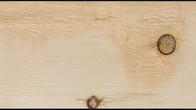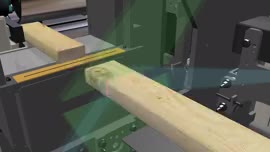LHG Laser Scanning X Skip X  Dog Holes X  Torn Grain X  Machine Burn X  Raised Grain X  Gouge X  Canter Head Scallop X  Saw Step X  Lumber Characteristics - Manufacturing Defects:
 Skip Areas where the planer failed to surface the board. This is usually caused by errors in sawing which results in a rough board that is undersized in either the thickness and/or width.  Dog Holes Holes or marks caused by rough handling of logs, cants or boards in the manufacturing process. These can be the result of picaroons, tongs, dogs, turners, etc.  Torn Grain Small pieces of wood that have been torn or broken from the dressed lumber surface. Usually occurring around knots or irregular growth where knives are cutting against the grain. Planer feed speed and chip breaker setup can also contribute to this defect.  Machine Burn An area where the wood has been overheated. Caused by a machine knives or rolls rotating on the same spot when the feed is interrupted.  Raised Grain Height difference between hard summerwood and softer springwood on the surface of the dressed lumber. Can be the result of dull planer knives, too much land, insufficient clearance angle or excessive pressure from feed rolls.  Gouge Groove cut across the full width of the face and extending below the desired surfacing level. Usually the groove is an inch or so in length.  Canter Head Scallop Channel cut out of the edge (s) along the length of the piece (scallop). It is caused by mis-aligned chipper knives.  Saw Step Channel or step cut into the face of the piece. Usually accompanied by skip, especially in the lower step. Occurs in a Double Arbor Gang Saw setup when opposing saws are mis-aligned. | ||



